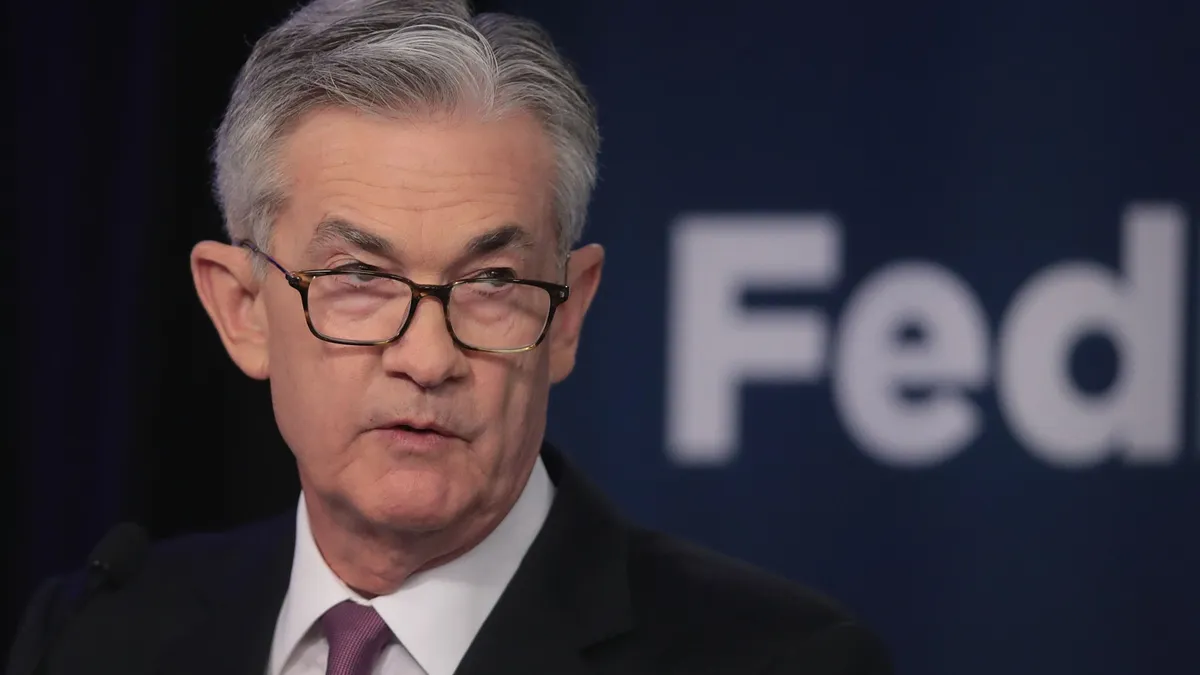Dive Brief:
- The Federal Reserve, after raising the main interest in 10 previous meetings, paused monetary tightening on Wednesday while increasing its median projection for the federal funds rate at the end of the year to 5.6% from 5.1% in March.
- “Holding the target range steady at this meeting allows the [Federal Open Market] Committee to assess additional information and its implications for monetary policy,” the FOMC said in a statement after a two-day meeting that concluded with a unanimous decision to keep the main interest rate within a 5% to 5.25% range. The FOMC between March 2022 and last month raised the benchmark rate from near zero to the highest level in 16 years.
- Fed officials, in a median projection, forecast that their preferred measure for inflation — the core personal consumption expenditures price index — will end the year at 3.9%, an increase of 0.3 percentage points from their forecast in March.
Dive Insight:
Fed Chair Jerome Powell said during a press conference that policymakers suspended rate hikes to take time for assessing the impact from 14 months of monetary tightening. Rate increases usually require a year or more to restrain economic growth, the job market and price pressures.
Despite the pause, Powell emphasized that Fed officials are still determined to reduce inflation to the central bank’s 2% target.
The FOMC “is completely unified in the need to get inflation down to 2% and we’ll do whatever it takes to get it down to 2%,” he said. “We understand that allowing inflation to get entrenched in the U.S. economy is the thing that we cannot, cannot allow to happen for the benefit of today’s workers and families and businesses.”
No policymaker anticipates cutting the federal funds rate this year, Powell said, emphasizing that “the process of getting inflation back down to 2% has a long way to go.”
“Not a single person on the committee wrote down a rate cut this year, nor do I think it is at all likely to be appropriate,” he said. “Inflation has not really moved down — it has not so far reacted much to our existing rate hikes, and so we’re going to have to keep that in mind.”
Moreover, policymakers believe that, based on the data, inflation still poses significant risks, Powell said.
“I still think, and my colleagues agree, that the risks to inflation are to the upside,” he said. “What we’d like to see is credible evidence that inflation is topping out and then beginning to come down.”
Recent data underscore that the Fed’s most aggressive push against inflation in four decades has so far yielded mixed results.
The consumer price index slowed in May to a 4% annual rate compared with 4.9% in April, the Labor Department said Tuesday. The core CPI, which excluded volatile food and energy prices, eased to 5.3% during the same period compared with 5.5% in April.
Yet inflation persists at more than twice the central bank’s 2% target in part because policymakers have failed to cool the red-hot labor market and curb wage growth.
A springtime surge in job gains persisted last month as employers hired 339,000 workers and wage growth — while slowing from a 4.9% annual rate a year ago — rose 0.3% during the month and a still-strong 4.3% during the past 12 months.
Reducing price pressures will “ultimately require achieving a better balance between labor demand and labor supply,” former Fed Chair Ben Bernanke and former International Monetary Fund Senior Economist Olivier Blanchard said in a Brookings Institution study released Tuesday.
Powell said Wednesday that he agrees with the two economists’ opinion that reducing inflation hinges on slowing wage growth and better aligning the demand and supply of labor.
Economists at Goldman Sachs also agree, noting that a loosening in the tight labor market would reduce the odds that the Fed will trigger a recession as it tries to ease price pressures.
“The key issue to watch is whether the labor market can rebalance smoothly,” Goldman Sachs Chief Economist Jan Hatzius said in a note. “Most of the news in this regard has been positive,” he said, noting that unemployment last month rose to 3.7% from 3.4% in April.
Also, the quits rate, or the number of workers who left their jobs as a percent of total employment, has fallen to within the top of the range that preceded the pandemic.
Powell reiterated on Wednesday his longstanding confidence that the central bank can bring down inflation without significantly slowing growth or pushing up unemployment.
“There is a path to getting inflation back down to 2% without having to see the kind of sharp downturn and large losses of employment that we’ve seen in so many past instances,” Powell said.
Indeed, Fed officials on Wednesday raised their median projection for economic growth this year to 1% from 0.4% in March. They also predicted less harm to employment from higher interest rates, marking down their projection for unemployment at the end of this year to 4.1% from 4.5% in March.












